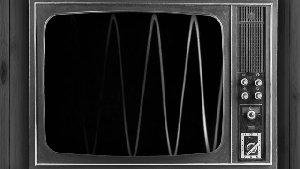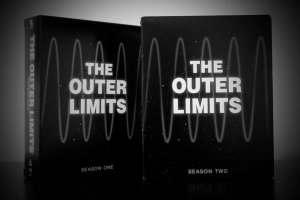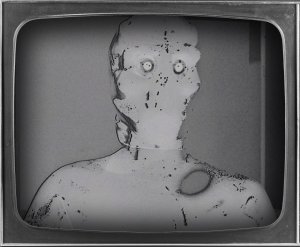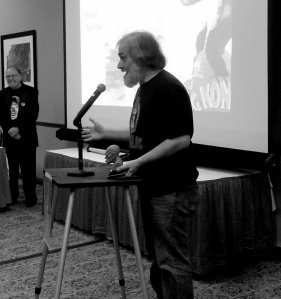
“There is nothing wrong with your television set. Do not attempt to adjust the picture. We are controlling transmission.”
These are the famous opening lines of the classic TV show The Outer Limits. Inspired by The Twilight Zone, another science fiction anthology series, The Outer Limits ran for two seasons on the ABC network from 1963 to 1965.

The landmark television show was recently restored and re-released in a two-volume Blu-ray box set by Kino Lorber Studio Classics. This new collection features the long-lost gem of the series: a surviving print of the original pilot episode, rescued from the black hole of history by Indianapolis film historian Eric Grayson.
“I saved the unaired pilot for the show, back when it was called Please Stand By, and they used my film print for the set and I did the commentary for it,” explains Grayson. “This lost pilot episode is the ground floor of what eventually became The Outer Limits, and you can see how the ideas started and began to develop.”

Grayson has been involved in film history, preservation and collecting for several years. He is also known to screen rare films, often from his own collection, on real projectors. Grayson says he is most proud of saving the James Whitcomb Riley film Little Orphant Annie from 1918 and preserving the 1954 Milan High School basketball final games.
When asked about the sci-fi series, Grayson recollects, “It had been long off the air when I was born, but The Outer Limits was always a favorite of mine. I discovered it on WXIN reruns in the ‘80s.”
Grayson and others involved in the Blu-ray sets recently received well-deserved recognition for their work at the 17th annual Rondo Hatton Classic Horror Awards ceremony. Held in Louisville, Kentucky earlier this month, the “Rondos” continue to honor the best in classic horror research, creativity, and film preservation.
The Lost Pilot – The Galaxy Being is technically the first episode of The Outer Limits that features the classic opening and title screen. But the version Grayson rescued for the box set is the original cut of this episode, when the show was titled Please Stand By, which he found mislabeled on a dealer’s table many years ago.
“Some time later, the series producer and co-writer, Joseph Stefano, contacted me about another film and he was astonished that I had the pilot,” Grayson recalls. “Stefano told me that the film was cut differently from The Galaxy Being version to make it shorter. The special effects are slightly different, and most importantly, the opening and closing credits are different.”

Stefano and series creator Leslie Stevens came up with the idea to call the show Please Stand By, but the executives at ABC hated the idea, Grayson says. They thought most of the audience would change channels when they saw the “Please Stand By” titles, possibly thinking something was wrong at the TV station.
Grayson fondly remembers the phone calls with Stefano. “It’s not often I get to speak to a film creator about one of his own works. Most of the time, people who worked on the films I restore are long dead.”
When the Blu-ray releases were in the works, Kino Lorber contacted Grayson after Stefano’s widow and others knew he had the best copy of the unaired pilot. He says the 16mm film was in great shape and did not need much restoration work.
“I simply supplied the film to Kino Lorber and they cleaned it up. When they got it scanned, they returned the film print and sent me a hard drive with time code to record the commentary, which was a lot of work but fun.”
A Television Legacy – The Outer Limits remains relevant and influential today for many reasons, especially the “look” of the show, Grayson says. The series creators were inspired by the 1920s German expressionists and the 1940s Val Lewton films, and worked to create a lighting style that was dark and mysterious while masking their low budgets.

“The Outer Limits has a very rich cinematic look to it. Many of the episodes were shot by the top cinematographers of the era, in particular Conrad Hall, who went on to win some Oscars,” Grayson explains. “They were also able to snag actor Cliff Robertson on his way up the ladder to stardom, which helped the series a lot.”
While the comparisons to The Twilight Zone are obvious and frequent, Grayson notes that the differences are what also gives The Outer Limits its staying power. “The Twilight Zone usually relied on twist or surprise endings, which didn’t happen with Outer Limits very often. The stories were more fleshed out because they were an hour instead of Twilight Zone’s 30 minutes.”
The show also stood apart from its contemporaries in the thematic sense as well. Science fiction stories tend to warn us of the future, but The Outer Limits broke from these themes, Grayson says. “It was usually not a warning about technology and the world to come, but instead an exploration of human frailties when confronted with new concepts.”
Grayson recalls that Stefano was disappointed that the 1990s reboot of The Outer Limits started incorporating the “warning” concept in its shows, something that he always fought against.
“Even in the first episode, The Galaxy Being creature is not evil. He does kill, but unintentionally. It’s the humans who can’t handle him, not the other way around. When there were evil monsters or aliens, the struggle was often in how to deal with them rather than issuing a warning of the future. In that way, The Outer Limits is still unique in its outlook.”
Eric Grayson hosts Vintage Movie Night at Garfield Park, the longest-running classic film series in Indianapolis. Follow Eric’s blog, check out his website, or find him on Facebook.
Follow Jeremiah Beaver at FOX59.com and on Twitter: @JerBearMedia










